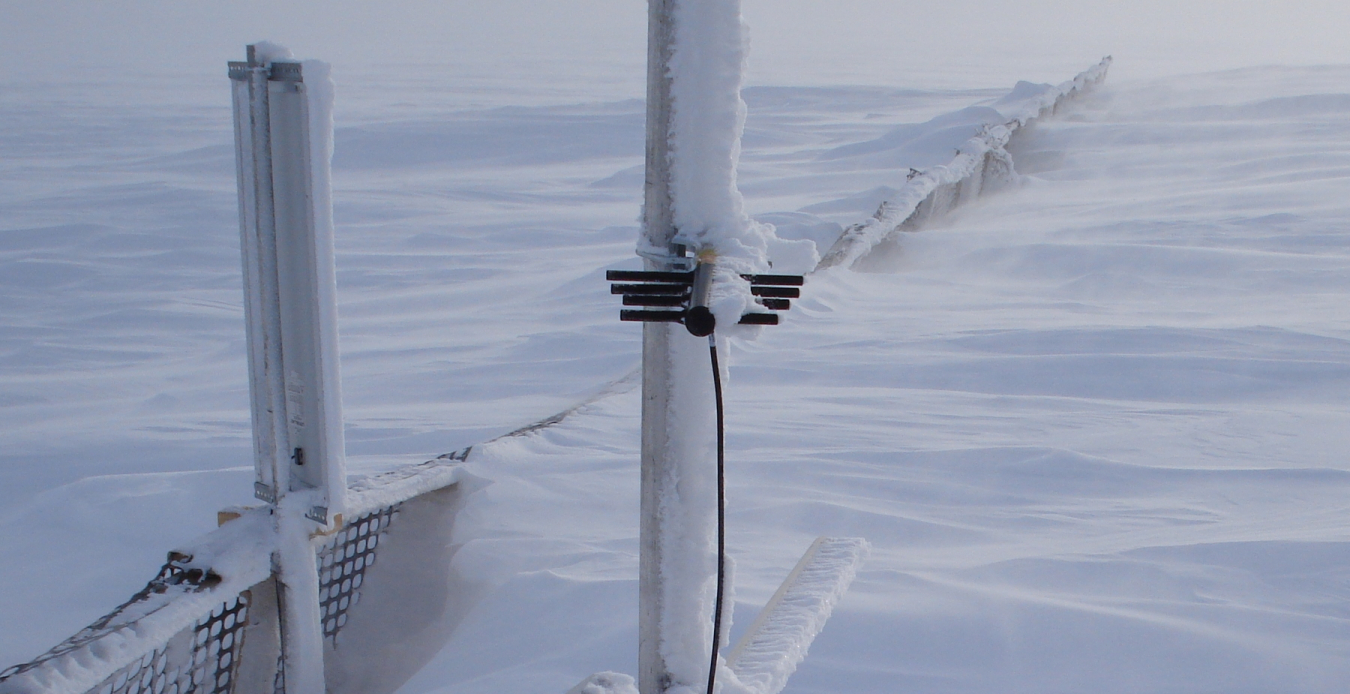
Monitoring equipment and part of the snowfence peek out of the snow drift.
The aerial view shows the experimental lake at Franklin Bluffs used for the snowfence experiment.
Researcher Joel Bailey measures the density of the snow in this snow pit to determine the amount of snow in the drift and the water equivalent of the snow drift.
WASHINGTON, DC — In a project supported by the U.S. Department of Energy’s Office of Fossil Energy, and managed by the National Energy Technology Laboratory (NETL), researchers at the University of Alaska Fairbanks have demonstrated that the use of artificial barriers—snow fences—can significantly increase the amount of fresh water supplies in Arctic lakes at a fraction of the cost of bringing in water from nearby lakes. The results promise to enhance environmentally sound development of Alaska’s natural resources, lowering the costs of building ice roads used for exploring for oil and natural gas in Alaska. They could also be used to help augment fresh water supplies at remote villages.
Arctic fresh water lakes often provide the large amounts of water needed for village use and for the construction of ice roads for oil and natural gas exploration in Alaska. Spring snowmelt usually recharges these lakes, with subsequent drying of the lakes in summer when evaporation generally exceeds precipitation. The Alaskan Arctic Coastal Plain only receives an average of 10 inches of precipitation a year, so when yearly deficits in precipitation or excesses in evaporation occur, lake recharge is directly affected and water availability is reduced. This impacts ice road construction, which requires 1–1.5 million gallons of water per mile for an ice road 6 inches thick and 30–35 feet wide, according to estimates by the U.S. Bureau of Land Management. Many lakes in this “polar desert” also provide a habitat for aquatic life, so increasing the amount of water available is vital to the ecosystem.
In the Office of Fossil Energy–sponsored project, university researchers evaluated the use of snow management and snow barriers to augment lake water supplies. Two lakes with similar hydrological characteristics—such as precipitation, evaporation, groundwater, and storage—were selected and monitored for 3 years. The researchers left the first lake in its natural regime. At the second—located at Franklin Bluffs, 31 miles inland from the coast, in the high-wind and drift zone—they constructed a 300-foot long, 10-foot tall snow barrier to enhance snowdrift formation. During one snow-transport event, 6 feet of snow were added to the drift in just 2 hours. Without the snow barrier, this snow would have either been lost to sublimation or blown and deposited on the tundra or lakes farther from where it is needed.
Snow on the tundra typically melts by the end of May, but drifts by a snow barrier last about a month longer. At Franklin Bluffs, the enhanced drifts provided enough extra water to balance water lost to evaporation during the summer, increasing water volume available in the lake by 25–30 percent, despite low rainfall in 2010 and 2011. This totaled an extra 1.5 million gallons of water in 2010 and 1.8 million gallons in 2011, made available at only 1 cent per gallon—far below the 13-cents-per-gallon cost of trucking in water from the nearby town of Deadhorse.
Final data analysis will determine the effect of the snow barrier on snow distribution and sublimation, provide recommendations on snow-barrier location, and evaluate the lake’s hydrological response to snowdrift melt, providing researchers and developers with useful information on snow-control practices. Remote coastal villages, which often depend on snowmelt for their fresh water supplies, should also benefit. Some of these communities, such as the traditional Inupiaq village of Shishmaref, collect fresh water using a similar snow-barrier method. By providing recommendations on snow-barrier location and the cost of additional snowdrift water, results of this and similar studies can help decision makers with water-resources management and assist in mitigating the risks associated with unfavorable climate and hydrological conditions.
The snow-drift and additional-water estimates from the snow-barrier project are now being incorporated into the water-balance model of the North Slope Decision Support System (NSDSS), which is being developed by another research group at University of Alaska Fairbanks with support from the Office of Fossil Energy and NETL. The NSDSS will aid operators and regulatory agencies in the planning of cost-effective ice roads that also minimize environmental impacts to Arctic lakes and tundra.
<p>FECommunications@hq.doe.gov</p><p> </p>
